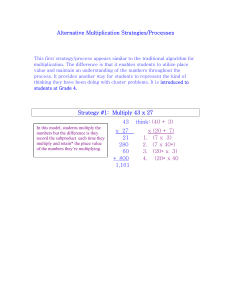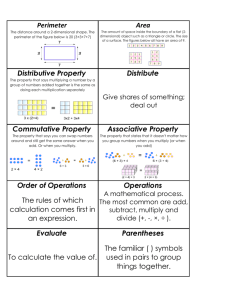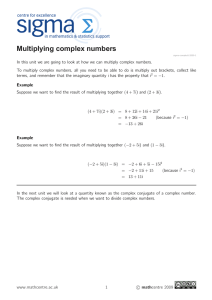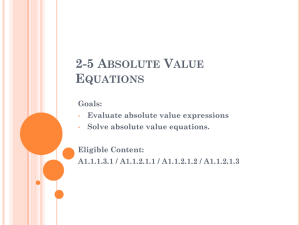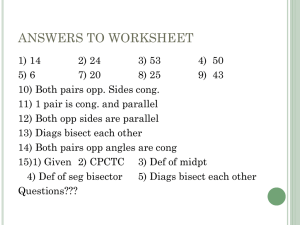Constructing a Slide Rule Alva Couch
advertisement
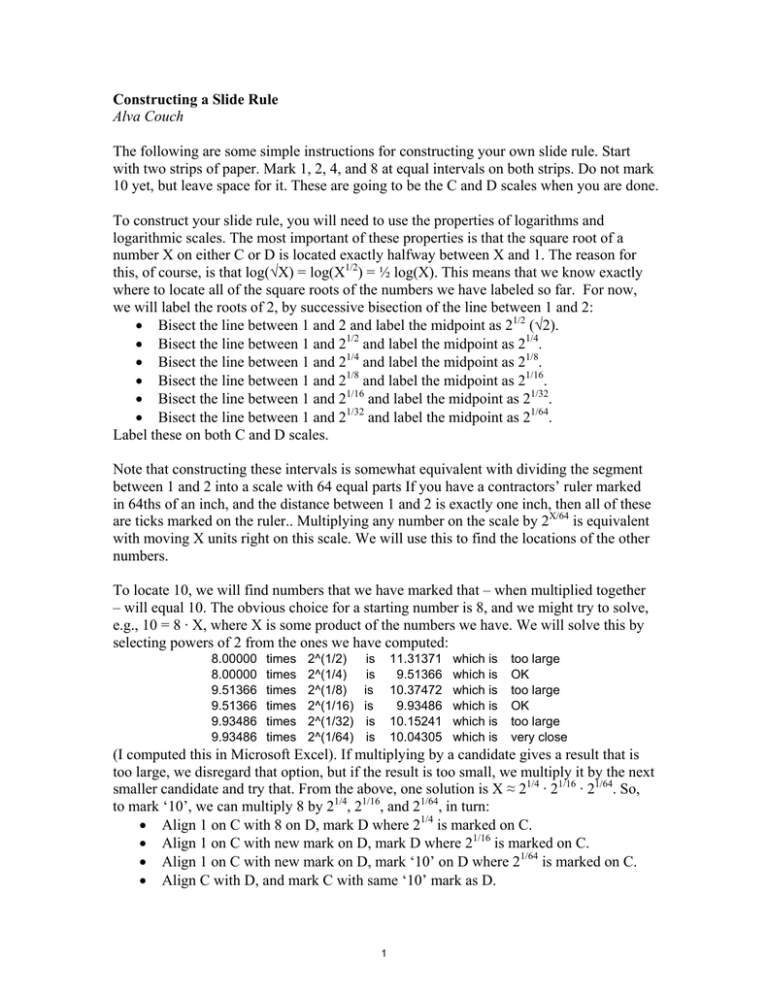
Constructing a Slide Rule Alva Couch The following are some simple instructions for constructing your own slide rule. Start with two strips of paper. Mark 1, 2, 4, and 8 at equal intervals on both strips. Do not mark 10 yet, but leave space for it. These are going to be the C and D scales when you are done. To construct your slide rule, you will need to use the properties of logarithms and logarithmic scales. The most important of these properties is that the square root of a number X on either C or D is located exactly halfway between X and 1. The reason for this, of course, is that log(√X) = log(X1/2) = ½ log(X). This means that we know exactly where to locate all of the square roots of the numbers we have labeled so far. For now, we will label the roots of 2, by successive bisection of the line between 1 and 2: • Bisect the line between 1 and 2 and label the midpoint as 21/2 (√2). • Bisect the line between 1 and 21/2 and label the midpoint as 21/4. • Bisect the line between 1 and 21/4 and label the midpoint as 21/8. • Bisect the line between 1 and 21/8 and label the midpoint as 21/16. • Bisect the line between 1 and 21/16 and label the midpoint as 21/32. • Bisect the line between 1 and 21/32 and label the midpoint as 21/64. Label these on both C and D scales. Note that constructing these intervals is somewhat equivalent with dividing the segment between 1 and 2 into a scale with 64 equal parts If you have a contractors’ ruler marked in 64ths of an inch, and the distance between 1 and 2 is exactly one inch, then all of these are ticks marked on the ruler.. Multiplying any number on the scale by 2X/64 is equivalent with moving X units right on this scale. We will use this to find the locations of the other numbers. To locate 10, we will find numbers that we have marked that – when multiplied together – will equal 10. The obvious choice for a starting number is 8, and we might try to solve, e.g., 10 = 8 · X, where X is some product of the numbers we have. We will solve this by selecting powers of 2 from the ones we have computed: 8.00000 8.00000 9.51366 9.51366 9.93486 9.93486 times times times times times times 2^(1/2) 2^(1/4) 2^(1/8) 2^(1/16) 2^(1/32) 2^(1/64) is is is is is is 11.31371 9.51366 10.37472 9.93486 10.15241 10.04305 which is which is which is which is which is which is too large OK too large OK too large very close (I computed this in Microsoft Excel). If multiplying by a candidate gives a result that is too large, we disregard that option, but if the result is too small, we multiply it by the next smaller candidate and try that. From the above, one solution is X ≈ 21/4 · 21/16 · 21/64. So, to mark ‘10’, we can multiply 8 by 21/4, 21/16, and 21/64, in turn: • Align 1 on C with 8 on D, mark D where 21/4 is marked on C. • Align 1 on C with new mark on D, mark D where 21/16 is marked on C. • Align 1 on C with new mark on D, mark ‘10’ on D where 21/64 is marked on C. • Align C with D, and mark C with same ‘10’ mark as D. 1 Note that multiplying by 21/4 · 21/16 · 21/64 is the same thing as multiplying by 21/4+1/16+1/64 = 221/64, which is the same thing as moving 21/64 of the distance between 1 to 2, to the right of 8. Also note that this calculation follows the same pattern that innovators contemporary to Galileo – such as Napier – used to calculate logarithms by hand. To compute X = logA(B), one tries powers X as candidates for solutions of AX=B, and tries to get one “digit” of the power correct at a time. If 10=8·2X, then X = log2(10/8). By that method, in base 2, we have just computed that log2(10/8) ≈ 21/64. Don’t worry if you cannot accurately multiply by 1/64, because if you cannot, it doesn’t matter much. Your slide rule’s accuracy cannot exceed the limits of your vision. Note that you are using your slide rule “as a slide rule” and simply multiplying by the numbers you have already marked. Accordingly, if you were building a huge slide rule, you might want to consider marking 128ths or 256ths or even 1024ths rather than 64ths. Next we use the laws of proportion to locate 5: • 10 is to 2 as 5 is to 1. So line up 10 on C with 2 on D, and mark 5 on C where 1 falls on D. Do the same thing again, reversing D and C. Next we need to locate 3. By the same process explained above, 3 ≈ 2 · 2 1/2 · 2 1/16 · 2 1/32 (log2(3/2) ≈ 19/32). So, we proceed as before, marking the result of those multiplications as ‘3’ on both scales. Then we use laws of proportion to compute 6 and 9: • Multiply 3 by 2, mark as 6. • Multiply 3 by 3, mark as 9. Finally, we need to mark 7. By the process explained above, 7 ≈ 6 · 2 1/8 · 2 1/16 · 2 1/32 (log2(7/6) ≈ 7/32). So, we proceed as before, marking the result of that multiplication as 7 on both scales. At this point we have marked 1-10, as well as the roots of 2. We can mark other numbers that are ratios of these. We can mark all ratios containing 2: 3 5 7 9 is to is to is to is to 2 2 2 2 as as as as 1.500 2.500 3.500 4.500 is to is to is to is to 1 1 1 1 Other easy numbers to mark include the reciprocals (some we have marked already, shown in gray). 2 1 1 1 1 1 1 1 1 is to is to is to is to is to is to is to is to 2 3 4 5 6 7 8 9 as as as as as as as as 0.500 0.333 0.250 0.200 0.167 0.143 0.125 0.111 is to is to is to is to is to is to is to is to 1 1 1 1 1 1 1 1 Note that just as in slide rule calculations, we drop the decimal point, and label the position for .333 with “3.33”! To mark the other halfway points (5.5-9.5) we must repeat the process shown above. The general construction for a number X is to choose a nearest number Y, and then find some fractional power Z so that X = Y · 2Z . If X is close enough to Y, then Z may be expressed (uniquely) as a sum of some subset of the numbers 1/2, 1/4, 1/8, 1/16, 1/32, 1/64, … by the “fundamental theorem of arithmetic” in base 2. This, in turn, means that one can reach X by multiplying Y by 2 to the sum of powers in the subset, as we did above. (If you were doing this professionally, you would consider the possible ways of forming 3 from all “constructible numbers”, which are the current marks, their square roots, their 4th roots, etc. To construct the position of an arbitrary number, you might want to, e.g., multiply a square root times a 4th root, or even form a product of three square roots, etc.) 3 MIT OpenCourseWare http://ocw.mit.edu EC.050 Recreate Experiments from History: Inform the Future from the Past: Galileo January IAP 2010 For information about citing these materials or our Terms of Use, visit: http://ocw.mit.edu/terms.

